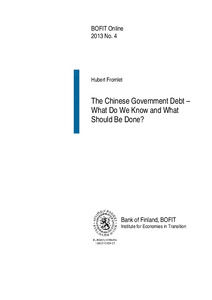The Chinese government debt : What do we know and what should be done?
Fromlet, Hubert (11.03.2013)
Numero
4/2013Julkaisija
Suomen PankkiBank of Finland
2013
Julkaisun pysyvä osoite on
https://urn.fi/URN:NBN:fi:bof-2014080828Tiivistelmä
A review of the economic press and literature reveals that there is little research and analysis on the important issue of the Chinese governmental debt and budget deficits. This is astonishing since the Chinese economy has by now climbed to the second position in global GDP ranking. Thus, China's government debt matters increasingly to the rest of the world as well, both in a corporate and a macroeconomic perspective. Furthermore, not enough is known about the real size of the total Chinese government debt. Insufficient statistical transparency is an important reason for this shortcoming, but this should not serve as an excuse. Increasing efforts are needed to provide China and the rest of the world with better information on the real state of Chinese government debt. In this paper, an attempt is made to explain and discuss the real situation when it comes to the Chinese government debt. The current Greek/Southern European debt misery clearly shows that opaque statistics cannot be hidden away forever without sooner or later puzzling and/or frightening the financial markets. On the other hand, China cannot be analyzed completely with Western eyes. The sooner Chinese decision-makers decide on greater transparency in the government debt situation, and decisive steps towards more efficient fiscal policy are taken, the better the consequences for China itself and the global economy. The alternative - continuous opaqueness and a possible future fiscal explosion - could certainly do a lot of harm to China, but also to the global economy. There is no reason to underestimate this medium and long-term risk. The short-term perspective looks safer. There should be room for a greater exchange of views and co-operation between EU and China, too. The EU's own bad experience from the past few years could be a realistic starting point. JEL Classifications: D02, D82, H70, H74, O53, P35
